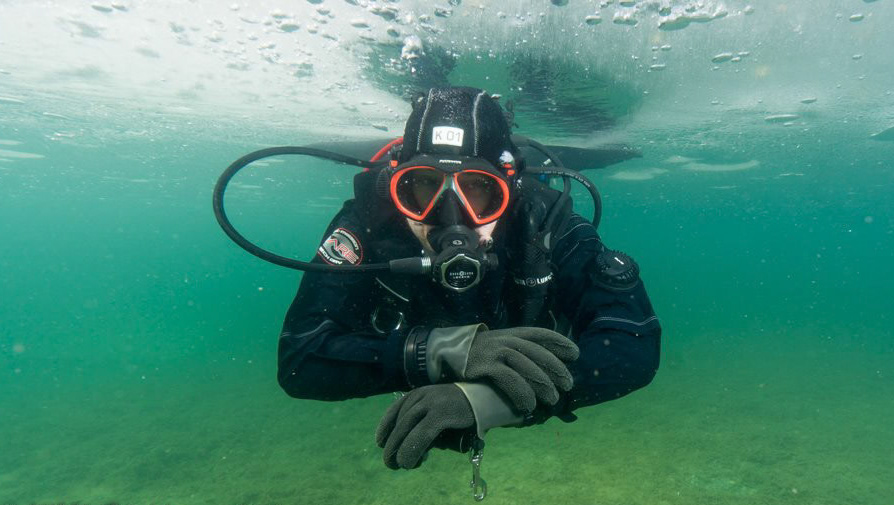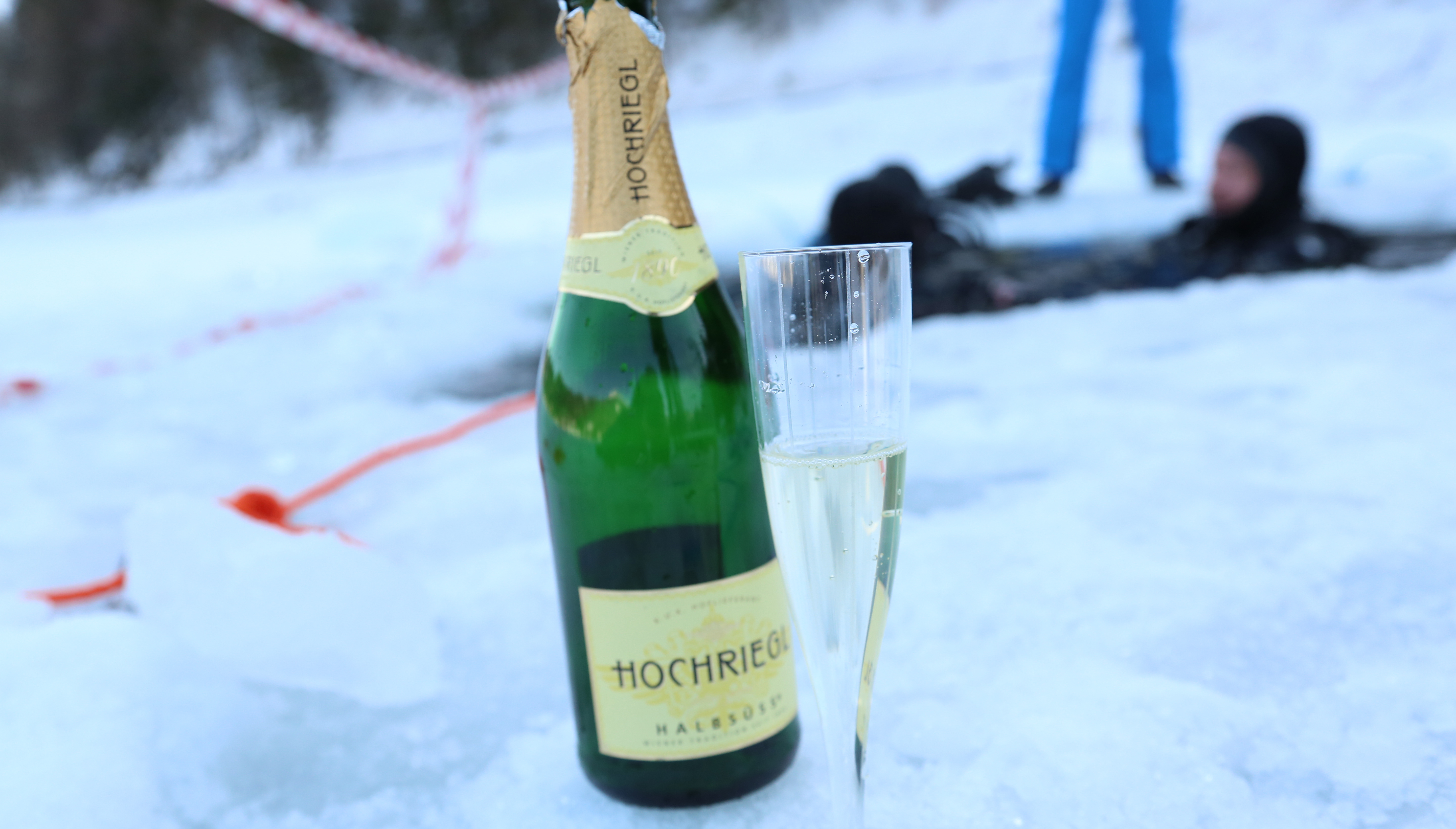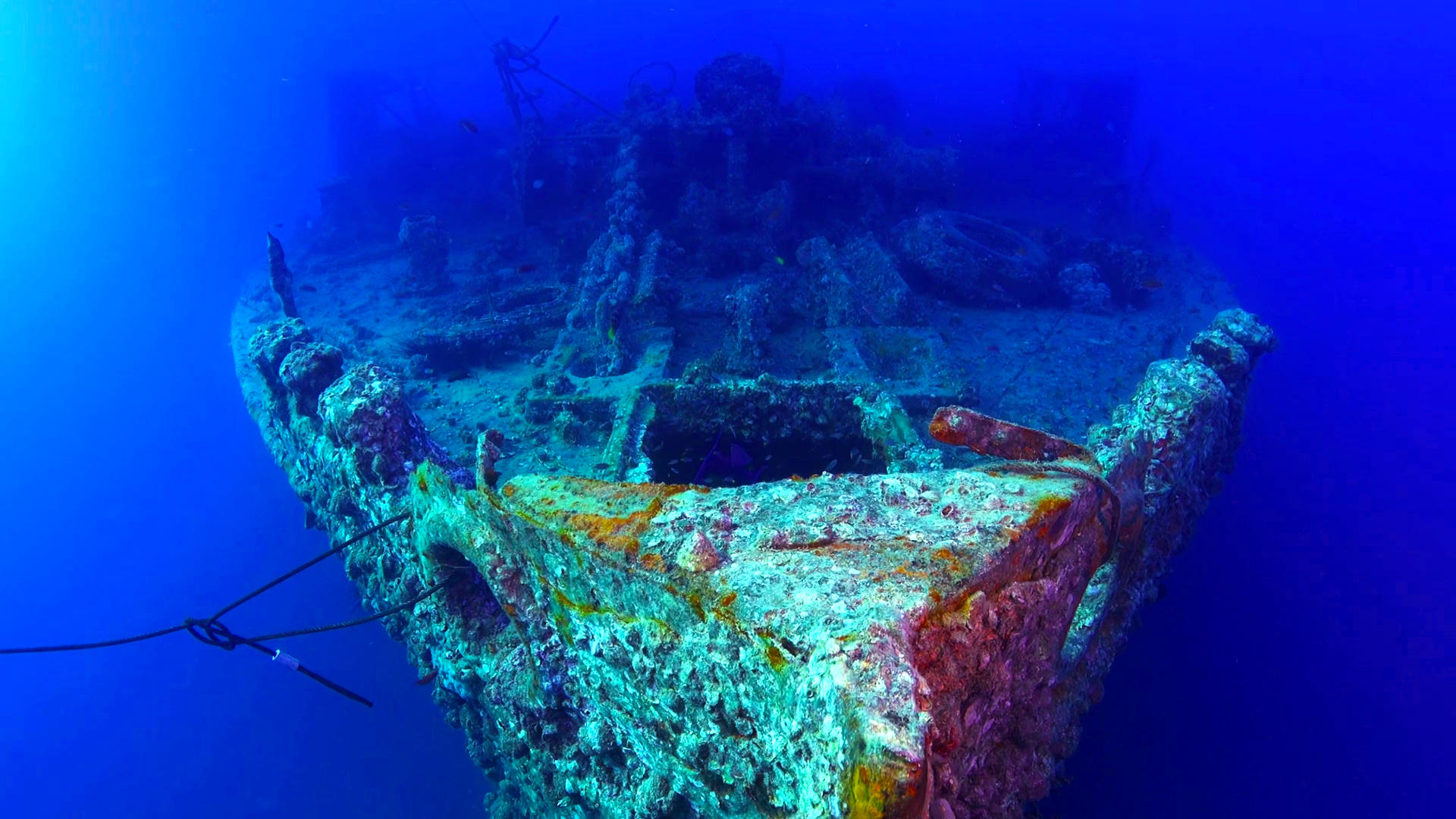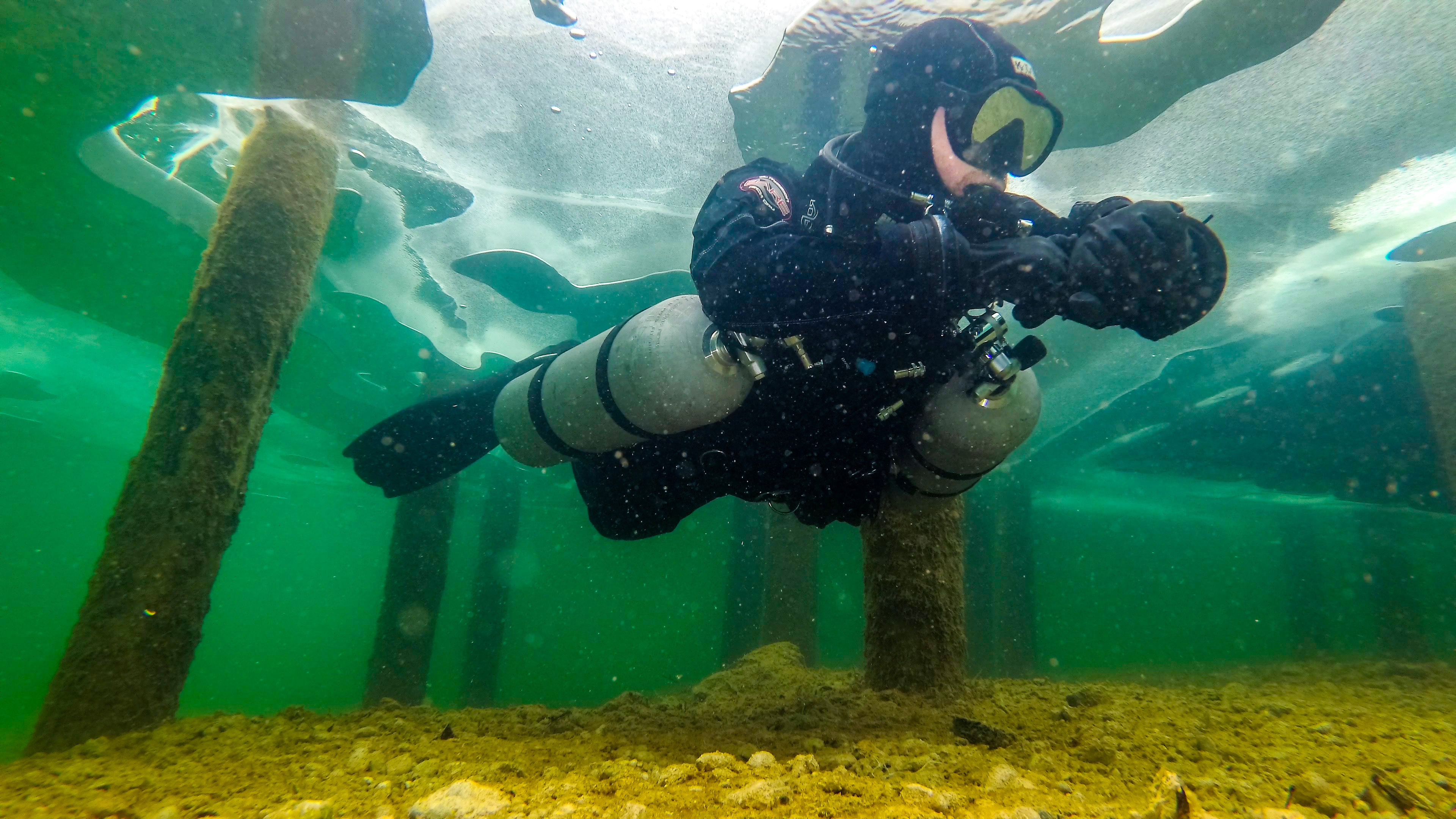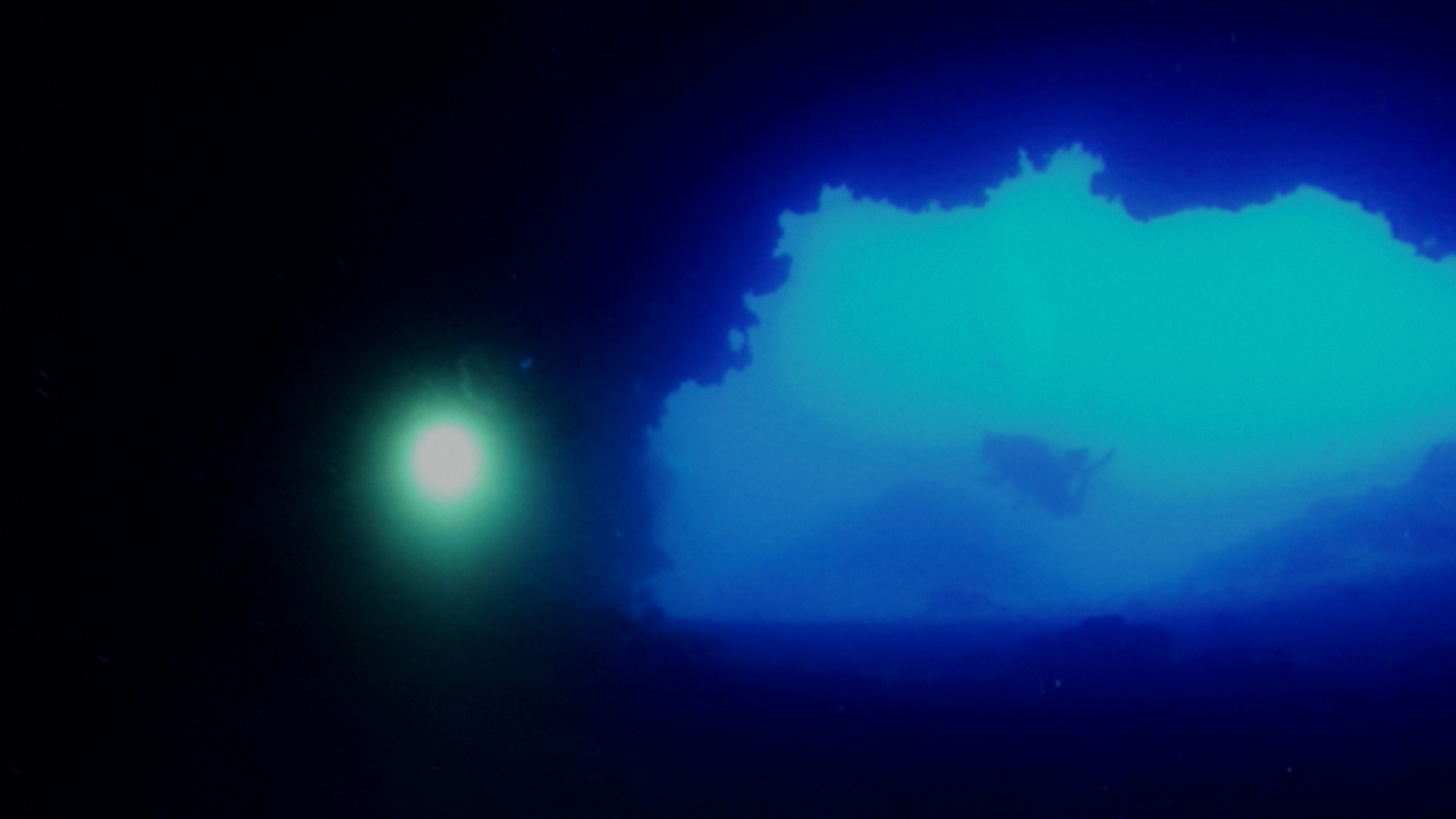February 23, 2017 - A frozen lake, it's just "Icing on the Cake" - Part 1
When I tell people how passionate I am about scuba diving, most people respond positively, with excitement. They're curious about it all and ask about my favourite destinations and whether I miss the sea already and how much longer until I get to dive again.
"Of course I miss the sea." I tell them, "but I'm going diving this weekend, so I won't have to wait much longer!"
Their eyes open wide and they appear confused; how does one go diving in a landlocked country, they ponder. Well sure, there are rivers and lakes and divers within those are not unheard of, "but isn't it winter?" they ask. They reach for their phone and check the date, just to be sure.
I tell them, "I sure hope so, I'm going ice diving. In the summer that would prove to be quite the challenge."
Diving just right below a thick layer of ice and snow, a moment of pure thrill.
Photograph by © Wolfgang Rotschek - www.letsdive.at
About a week before the trip, I got in touch with Wolfgang Rotschek, regarding a course I wanted to do with him in the future. He is a passionate and skilled diver and instructor with a vast amount of experience in caves and below ice. As the conversation went on and we bounced from subject to subject, he told me about his upcoming trip. I mentioned how I'd be interested to go ice diving next year myself. "Why wait?" he asked, "You should come along!"
I thought about this for a moment and realised, my birthday was going to be a few days prior and also my total number of logged dives were approaching another milestone; I could doubly reward myself and celebrate in a special way. "Now you just have to do it!" Wolfgang stated.
At 827m above sea level lies the beautiful 'Erlaufsee'. Diving here also entails altitude diving.
Joined by two courageous companions, Miriam and Eva (they went on their very own adventure), I packed my gear and we headed south, leaving the temperate city of Vienna behind us, longing to see some snow again. That evening we met Wolfgang and the rest of the divers at the local inn, at which we would stay those couple of days. We delved right into the theory needed for ice diving; all the things one needs to know about the formation of ice and dangers involved, as well as precautions required, to make everything safe. A lot of details come to light, things one might not consider outside a professionally taught class.
Breaching the ice, to make a hole for the actual penetration: No easy task, even when a chainsaw is involved.
Finally the day of diving arrived. We drove up to the lake and started lugging our gear through the snow toward where we'd make our entry. Wolfgang and another diver, Sascha, had been here the day before and had already cleared away some of the snow. It was time to cut a hole into the ice. Rebreather diver Lukas brought the much required chainsaw and it began making easy work of the nearly 30-40cm of ice. Or so we thought...
Clearing some lanes in the snow, for the sunlight to pass through, making navigation toward the entry/exit simpler. Up next, making the cut.
Within minutes the chainsaw choked. We couldn't get it running again, so lucky thing we were equipped with hatches and axes. Chopping into the ice, a couple of blocks were removed, revealing the actual thickness of what we stood on. Safe to say, a car wouldn't break through, let alone our axes. We would probably still be there now, hadn't the chainsaw made for a glorious comeback and then ultimately, after almost 45 minutes, made easy work of our cold flooring.
Securing the huge cutout with an ice screw and then pushing it beneath the main ice, the opening toward the lake finally revealed itself.
The ice finally breached, it was time to gear up. Everyone cautiously set up their scuba sets and then donned their respective drysuits. I only recently acquired my suit, having worked solely with rentals before, in order to comfortably extend my diving season into late autumn and early spring. Such extremes, would be a first for me. Varying layers of undergarments are key to resisting the cold. The tricky part is, that whilst working things out on the surface and donning your gear, one can quickly build up a sweat, which in turn is now sealed in with the diver, who will take it with him beneath the surface, where it will cool off and more dangerously, the diver himself. The key is, to take it easy, take it slow.
Sascha Voelz helping me ready up for the dive. I'm taking it slow as to avoid a sweat.
Mind you, not too slow. After all, one team needs to stay on the surface and handle the tethers; surely they want to have some fun too at some point.
And as it goes, we're in the water, my buddy Hermi, Wolfgang and myself. We take a minute to get used to the freezing waters, leaning back and gently floating on the surface, making sure our first stages are fully submerged.
The air outside is colder than the water beneath the ice. Submerging the first stages, allows them to warm up, as to avoid a free flow incident.
Floating in the water, I was able to observe, the contours of the triangular shape we had cut out of the ice. A layer of packed snow lay atop another, thicker layer of pure ice, clear as glass and even smoother, all merged into one tough solid floor. The edges where the chainsaw made it's cut, were immediately being softened by the warmer waters, Smaller fragments of ice, broken off during the breach, were left to float within the exposed water, drifting through it like tiny arctic icebergs.
I moved my hand to feel the structure of the ice from below the surface. I anticipated some structure, something wavy or bumpy, remnants of the water's movement beneath the ice. None of that; the lake was not only literally frozen, but also figuratively, frozen in time. The bottom made for the flattest surface I had ever seen or touched.
Tiny fragments of ice, reminiscent of glass, melting rapidly in the water.
Finally ready and anxious for the next step, came the time to make our descent through our beloved triangle. One last look around at all those small pieces of ice, now melted, larger pieces manually removed. My buddy Hermi and myself signal to one another 'Ok' and 'Descend', trying to make for a semi dignified attempt at sinking into the frozen darkness, whilst messing around with the tethers to which we are attached; an unfamiliar feeling.
As we exhale, the first bubbles that emerge on the surface, captured in a still frame, so perfectly emulate a lump of ice; I wonder would the unaware observer, be able to tell the difference?
The first moments going down made for a vivid experience! Before donning my mask, I had cooled off my face with the icy waters. Despite this, upon submerging, for the first couple of moments I believe, I noticed a prickling sensation on my face, reminiscent of pop rocks, when the warmer parts react to the their colder surrounding.
Seconds later, I'm about 2 metres deep and make contact with Hermi, we signal "OK" to one another and try to figure out our positioning, relevant to our tethers. We respond to our instructor, Wolfgang, who during our descent kept a watchful eye.
Our entry/exit as viewed from beneath the surface; The snow atop the ice gently diffusing the ambient light, making for a mesmerising scatter effect.
Photograph by © Wolfgang Rotschek - www.letsdive.at
It's about now when it suddenly hits me... Last time I went diving in this lake, it was summer and visibility was no more than 5 metres. This was not the case this time. We have some disagreement still, as to how far one could actually see, but especially during that very first dive, I remember how clear the water was and how effortlessly the beam of my torch cut through it. We passed a familiar structure, a submerged platform for open water students to practice their skills on in the summer, at a depth of 5 metres. Another platform at a depth of 10m is close by and normally one wouldn't be able to see from one to the next. It was different this time.
As we venture away from the entry/exit, less ambient light manages to push through the layer of snow above us, despite the shallow depth. The use of a torch, becomes the only means to see colours beyond the lake's green tint.
Video Freeze Frame - Courtesy of Lukas Glanz
The first dive served to get familiar with the setting, familiar to diving attached to one's buddy and by extension, the whole buddy team attached to a team of tenders on the surface. It's an usual feeling, a sense of freedom removed; freedom one has come to know when diving normally.
I recall the stories of divers, without proper training or sufficient safety precautions, who entered such an overhead environment and succumbed to the ice, when they failed to find their way back out.
I recall the stories of divers, without proper training or sufficient safety precautions, who entered such an overhead environment and succumbed to the ice, when they failed to find their way back out.
Both ice divers are connected to the same tether; the diver in the middle leading it and staying connected to the line tenders on the surface.
Photograph by © Wolfgang Rotschek - www.letsdive.at
It's Hermi's turn in the middle, leading the tether. She takes comfort in the gentle drag the rope causes. It's a sign that the tenders on the surface are holding on strongly enough, for there to be the required tension needed to communicate with us, but there is slack enough to avoid pulling us back unwittingly. On occasion, Hermi makes a single strong tug; a signal to give us some slack. A single tug returns from the surface - a signal to let us know, we have expired the full length of rope.
Just shy a few fin kicks of a drowned tree, buried down in the water, we are reminded of how we have less freedom of movement, compared to normal scuba divers. If we want to venture out further, I guess we'll have begin our cave training next.
A neverending ceiling of snow and ice, an astonishing view to behold.
Video Freeze Frame - Courtesy of Lukas Glanz
Nothing to fret. We may not be able to cruise great distances in a single direction, but we have a radius at our disposal; navigation is less of an issue when tethered. We start to circle round, noticing how the tether begins to slack. The tenders take a moment to respond and withdraw some line, recreating tension.
As we slowly reach the exit, a silhouette emerges. It's one of the tenders I presume and I spot a red pattern on a drysuit; it's Leo Görlitzer.
The way light is perceived below ice, heavily depends on whether or not snow lies atop it.
Video Freeze Frame - Courtesy of Lukas Glanz
Leo greets us on the surface. "Did you have fun?" he inquires, "How's the view?" he goes on; curious about the conditions and presumably eager to assume his turn in the water. Leo and Sascha help us doff and secure our scuba gear while we're still in the hole. With a quick leap, I exit and assume my turn as a tender, helping the others get into their gear and then keeping them safe, whilst they make their descent now.
After a second dive each, we had time for a couple of group photos, before retrieving the cutout we had made earlier that day. We sealed off our dear triangle, marking the area with construction tape, to keep unaware passersby from accidentally falling into the lake.
Back at the inn, we laugh and cherish the day that had just transpired, whilst we share a beer. We talk about what awaits us the next day whilst Freddy, the innkeeper, was preparing dinner for the entire group and all our friends who had joined us by now.
I take a moment to open up my logbook, when I notice I had miscounted the number of dives I had already logged. I erred in thinking I was going to reach a milestone this weekend, but in actuality, was going to come back from this trip just shy two dives.
It doesn't matter though, really. It was just a story to tell, an excuse for myself, to go on this adventure. It merely would have been... icing on the cake.
Pictured from right to left, Instructor Wolfgang, divers Lukas, Hermi and myself.
Photograph by © Wolfgang Rotschek - www.letsdive.at
Stay connected for any Lost at Sea news and updates, by subscribing to our newsletter!

